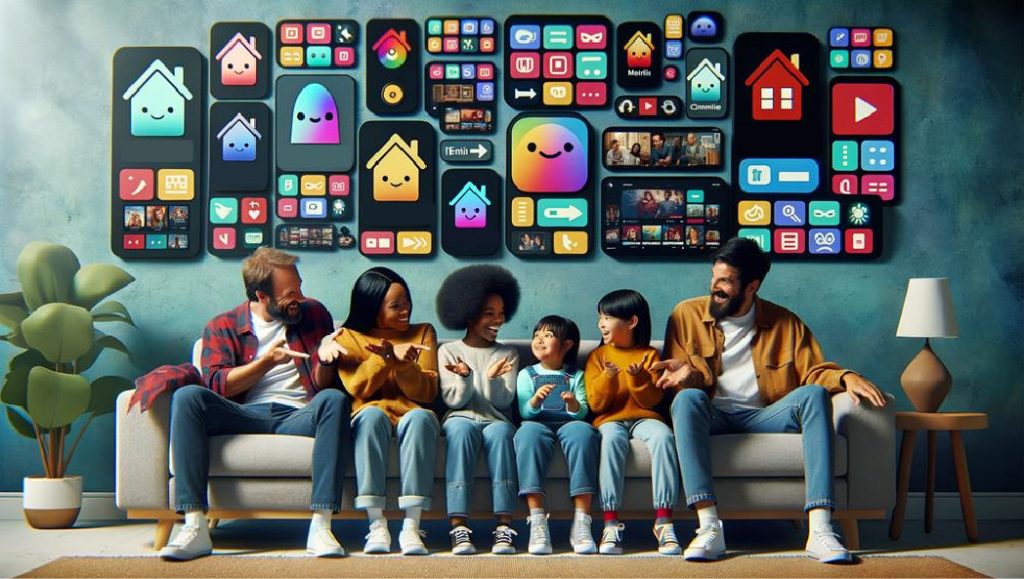
Online TV signifies a pivotal shift in media consumption, moving away from traditional broadcasting to digital platforms that offer on-demand content accessibility.
This transformation is driven by consumer demand for immediate and diverse media access and has led to significant industry disruptions, particularly in the advertising and content delivery sectors.
Online streaming provides personalised viewing experiences across multiple devices and often at a more thorough cost compared to traditional cable services.
However, this shift presents challenges such as increased content regulation, reliance on strong internet connectivity, and privacy concerns with viewer analytics.
Exploring these nuances further could lead to a more in-depth understanding of the changing television landscape.
Quick Summary
- Online TV offers on-demand access to a vast variety of global content.
- Streaming platforms provide flexible subscription models to suit different budgets.
- Multi-device compatibility allows viewing on smartphones, tablets, and smart TVs.
- Viewer participation and personalised content enhance user engagement.
- Requires a stable and fast internet connection for uninterrupted streaming.
Evolution of Online TV

As the digital landscape expanded, online TV underwent a transformative evolution, shifting from rudimentary streaming services to sophisticated platforms offering a diverse array of content.
This shift was heavily influenced by regulatory frameworks adapting to new digital realities.
Governments and regulatory bodies had to reconsider traditional broadcasting rules to accommodate the burgeoning online sphere, ensuring fair competition and consumer protection.
Simultaneously, consumer adaptation played a critical role. Audiences swiftly moved away from conventional TV viewing habits, embracing the flexibility and variety offered by online platforms.
This consumer shift not only demanded more from service providers regarding quality and accessibility but also accelerated the pace of technological enhancements and content diversification in the online TV sector.
Comparing Traditional and Online TV
The landscape of television consumption has been dramatically reshaped by the emergence of online TV, showcasing stark contrasts to traditional broadcast models with regards to accessibility, content variety, and viewer engagement.
Traditional TV, governed by scheduled programming and geographic limitations, often dictates viewing habits, confining audiences to specific times and channels.
In contrast, online TV thrives on subscription models that offer on-demand access to a diverse array of global content, allowing viewers to tailor their watching schedules.
This shift not only caters to individual preferences but also disrupts the traditional advertising-driven revenue model, challenging broadcasters to adapt.
The transformation in how content is accessed and consumed underscores a pivotal evolution in viewer expectations and behaviours.
Key Features of Online Streaming

Online streaming platforms revolutionise media consumption by offering several key features that enhance viewer experience and accessibility.
These platforms have greatly altered how content is consumed, moving beyond traditional passive viewing to a more engaged, personalised experience.
Key features of online streaming include:
- Vast On-Demand Libraries: Access to thousands of titles at any time caters to diverse tastes and preferences.
- Content Personalisation: Algorithms suggest shows and movies based on individual viewing habits, enhancing user engagement.
- Interactive Features: Viewers can rate content, create watchlists, and participate in interactive storytelling.
- Multi-Device Streaming: Seamless viewing across smartphones, tablets, PCs, and smart TVs provides flexibility and convenience.
These innovations not only cater to modern lifestyles but also elevate expectations for how media can be enjoyed and interacted with.
Top Online TV Platforms
In addition to the innovations of online streaming, several platforms have emerged as leaders in providing exceptional TV viewing experiences.
These top platforms have honed their subscription models, utilising tiered access to cater to diverse consumer budgets and preferences.
This strategic diversification not only broadens their market reach but also stabilises revenue streams, proving critical in a competitive landscape.
Moreover, the integration of sophisticated viewer analytics has been paramount.
By analysing viewing habits and preferences, these platforms can tailor content recommendations, enhance user engagement, and optimise advertising strategies.
This data-driven approach underscores a shift towards personalised viewing experiences, setting a benchmark in the industry and continually reshaping how content is delivered and consumed in the digital age.
How to Access Online TV

Accessing online TV begins with choosing a suitable streaming platform that aligns with one’s content preferences and budget constraints.
Once a platform is selected, the user must make sure that they have the necessary device compatibility and Internet requirements to facilitate a smooth streaming experience.
The process requires careful consideration:
- Device Compatibility: Verify that your device, whether a smart TV, smartphone, or tablet, supports the chosen streaming service.
- Internet Requirements: A stable and fast Internet connection is essential to avoid buffering and guarantee high-quality video playback.
- User Account Setup: Create an account or subscribe to the service, providing payment information if required.
- Software Installations: Install any required apps or software updates to maintain peak performance and security.
Approaching these steps analytically can prevent future frustrations and enhance your viewing experience.
Benefits of Streaming Services
Why should viewers consider switching to streaming services?
Streaming platforms offer unprecedented content variety, catering to diverse tastes and preferences that traditional TV cannot match.
From niche documentaries to blockbuster series, these services provide a wide array of choices that empower viewers to tailor their entertainment experiences.
Additionally, subscription flexibility is a significant benefit. Unlike traditional cable packages, streaming services allow users to select different subscription levels based on their viewing habits and budgetary constraints.
This adaptability not only enhances user satisfaction by preventing overspending but also avoids the long-term commitments often associated with cable TV.
The combination of rich content variety and adaptable subscription options fundamentally shifts the power to the consumer, redefining the viewing experience.
Challenges Facing Online TV

Despite the numerous advantages of streaming platforms, several challenges persist, including issues related to content licensing, internet dependency, and data privacy concerns.
The landscape of online TV is fraught with complexities that demand attention:
- Content Regulation: Maneuvering the global patchwork of regulations can stifle creativity and restrict access to diverse content.
- Viewer Analytics: While data drives customisation, it also raises significant privacy issues, as users’ viewing habits are constantly monitored.
- Reliance on Robust Internet: Uneven internet access across different regions can limit the reach and reliability of streaming services.
- Licensing Limitations: Content licensing often restricts availability across geographical boundaries, frustrating viewers and hindering universal access.
These issues underscore the need for robust solutions to foster the growth of online TV platforms.
Future Trends in Online TV
Addressing these challenges is imperative as we look toward the emerging trends shaping the future of online TV. One prominent trend is the shift toward interactive viewing experiences.
This involves viewers not just passively consuming content but actively participating through choices that influence the narrative outcome of shows, real-time engagement features, and personalised content recommendations.
Such developments demand robust data analytics capabilities and sophisticated user interface designs to enhance viewer engagement and satisfaction.
Simultaneously, global accessibility is becoming increasingly central.
As online TV transcends geographical boundaries, it necessitates innovative solutions in content localisation, compliance with diverse regulatory frameworks, and scalable distribution technologies to guarantee seamless global delivery.
These trends are critical in redefining the competitive landscape of online television, calling for strategic, forward-thinking approaches from industry stakeholders.
Choosing the Right Service

Selecting the appropriate online TV service requires a careful analysis of several key factors including content variety, streaming quality, and user interface design. It’s important to take into account:
- Content Variety: Does the service offer a diverse range of genres that cater to all your entertainment needs?
- Streaming Quality: Are you getting the best possible video and audio quality for an immersive viewing experience?
- User Interface Design: Is the interface user-friendly and intuitive, making navigation simple and stress-free?
- Subscription Costs and Device Compatibility: How does the cost compare to the value provided? Is the service compatible with all your devices, ensuring seamless access across platforms?
Carefully weighing these aspects will guide you in choosing a service that not only fits your budget but also enhances your viewing experience.
Impact on Traditional Broadcasters
The advent of online TV services has greatly impacted traditional broadcasters, challenging their long-established dominance in the media landscape.
These digital platforms have catalysed significant advertising shifts, drawing away substantial revenue streams that once flowed mainly through conventional channels.
Advertisers now prioritise online services due to their targeted reach and measurable impact, leaving traditional networks scrambling to adapt.
Additionally, regulatory changes are reshaping the field, as governments attempt to address the rapid evolution of media consumption.
Traditional broadcasters must navigate these regulations while also innovating to retain viewership and relevance.
This ongoing transformation signals a critical period for these entities, as they must evolve swiftly or face potential obsolescence in a digitally dominated world.
Frequently Asked Questions
Can Online TV Services Restrict Content Based on My Location?
Yes, online services can restrict content based on location due to licensing restrictions and geo-blocking methods. These practices guarantee compliance with regional copyright laws, although they often provoke criticism for limiting global access.
How Do Data Usage Rates Differ Between Live Streaming and Downloading Shows?
Data usage rates vary considerably between live streaming and downloading shows. Live streaming generally consumes more bandwidth, impacting data tariffs due to the continuous data flow required, whereas downloading involves a one-time data transfer.
Are There Family-Friendly Controls Available on Online TV Platforms?
Yes, many online platforms offer robust family-friendly controls, including parental settings and content filters, enabling parents to restrict inappropriate content and tailor viewing experiences to suit the age and sensitivity of younger viewers.
Can I Watch Online TV on Multiple Devices Simultaneously?
Yes, device compatibility and subscription plans often dictate the ability to stream on multiple devices simultaneously. Review the specific platform’s policies to confirm they meet your needs for simultaneous streaming across various devices.
Is There a Way to Enhance Streaming Quality on Slower Internet Connections?
To enhance streaming quality on slower internet connections, consider implementing buffering strategies and compression techniques. These methods can greatly reduce lag and improve video playback, ensuring a smoother viewing experience even with limited bandwidth.
Conclusion
To sum up, the evolution of online TV represents a significant paradigm shift in media consumption, challenging traditional broadcasting models with its on-demand, customisable nature.
Key challenges such as licensing, internet dependency, and market saturation must be addressed to sustain growth.
Future trends likely include further personalisation and integration of AI to enhance viewer experience.
As this sector grows, traditional broadcasters must adapt strategically to remain competitive in this rapidly changing media landscape.
